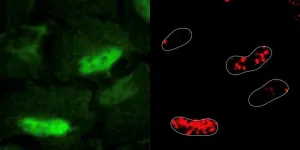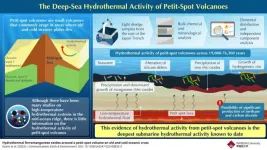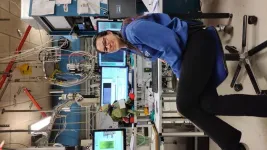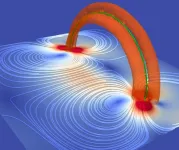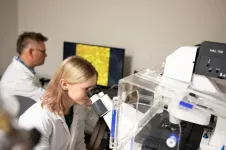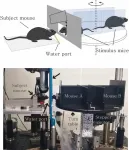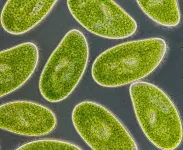(Press-News.org) EMBARGOED by Alzheimer's & Dementia: The Journal of the Alzheimer's Association, until June 1, 2023, 7 a.m., ET.
Contact: Gina DiGravio, 617-358-7838, ginad@bu.edu
(Boston)—Alzheimer disease (AD), the most common neurodegenerative disorder in the world, affects individuals of all races and ethnicities; however, most genetic research for AD has been performed on individuals of European ancestry (EA) with a limited number of large-scale genetic studies in other populations.
For many centuries, Ashkenazi Jews lived in communities in Eastern Europe and were genetically isolated from their non-Jewish neighbors. As a result, researchers from Boston University Chobanian & Avedisian School of Medicine hypothesized that some AD susceptibility variants are more frequent, and thus more likely to show statistically significant associations, in this group compared to much larger and more genetically heterogeneous EA cohorts.
“Our study illustrates the greatly increased power for detection of genetic associations in communities like Ashkenazi Jews who trace their lineage to a relatively small group of ancestors. In such communities, disease-associated variants may be much more frequent compared to samples ascertained from large, mixed populations,” explained corresponding author Lindsay A. Farrer, PhD, chief of biomedical genetics.
Farrer and his colleagues conducted a genome-wide association study for AD in a sample of approximately 3,500 individuals whose ancestry was almost exclusively Ashkenazi Jewish including roughly equal numbers of persons with AD and cognitively normal individuals who were identified in a much larger group of EA participants in large national AD genetics studies using an approach that compared genetic signatures with members of an Ashkenazi Jewish reference sample. The researchers identified several genetic risk factors for AD including some previously known (APOE, TREM2) and several novel ones that are strong biological candidates (RAB3, SMAP2, ZNF890P, SPOCK3, GIPR).
According to the researchers, this study illustrates the greatly increased power for detection of genetic associations in communities like Ashkenazi Jews who trace their lineage to a relatively small group of ancestors. “Some genetic association signals for complex diseases like AD are likely to be stronger in founder populations that are relatively genetically homogeneous,” said Farrer.
Although some of the findings in Ashkenazi Jews were not observed in other populations because of the rarity or absence of these genetic variants in those groups, Farrer believes the contribution of the genes harboring these variants to AD biology is likely relevant to other major populations in the world. “Future studies focused on the AD-associated genes identified in this study may lead to the development of novel AD biomarkers and therapeutic targets,” he said.
These findings appear online in the publication Alzheimer’s & Dementia: The Journal of the Alzheimer's Association.
Funding for this study was provided by NIH grants R01-AG048927, U54-AG052427, U01-AG058654, U01-AG032984, RF1-AG057519, U01-AG062602, U19-AG068753, and P30-AG072878.
END
BU researchers identify several new genetic risk factors for Alzheimer’s disease unique to Ashkenazi Jews
New study expands knowledge of the genetic architecture, biological pathways leading to AD
2023-06-01
ELSE PRESS RELEASES FROM THIS DATE:
DNA damage repaired by antioxidant enzymes
2023-06-01
In crisis, the nucleus calls antioxidant enzymes to the rescue. The nucleus being metabolically active is a profound paradigm shift with implications for cancer research.
Summary points
The human nucleus is metabolically active, according to the findings of a new study in Molecular Systems Biology by researchers at the CRG in Barcelona and CeMM/Medical University of Vienna,
In a state of crisis, such as widespread DNA damage, the nucleus protects itself by appropriates mitochondrial machinery to carry out urgent repairs that threaten the genome’s integrity
The ...
Petit-spot volcanoes involve the deepest known submarine hydrothermal activity, possibly release CO2 and methane
2023-06-01
Underwater volcanism on the Earth's crust are active contributors of many different elements to the oceanic environment. Hence, they play an important role in biogeochemical and chemosynthetic cycles of the ocean. Although there have been many studies on high-temperature hydrothermal systems in the mid-ocean ridge—a series of underwater volcanoes that trace the edges of the different oceanic plates—there is little information on low-temperature hydrothermal systems in other volcanoes, such as "petit-spot" volcanoes.
Petit-spot volcanoes are small volcanoes ...
Producing large, clean 2D materials made easy: just KISS
2023-06-01
Ever since the discovery of the two-dimensional form of graphite (called graphene) almost twenty years ago, interest in 2D materials with their special physical properties has skyrocketed. Famously, graphene was produced by exfoliating bulk graphite using sticky tape. Although it was good enough for a Nobel Prize, this method has its drawbacks. An international team of surface scientists has now developed a simple method to produce large and very clean 2D samples from a range of materials using three different substrates. Their method, kinetic in situ single-layer synthesis (KISS) ...
House of moveable wooden walls unveiled, promising a cheaper, greener alternative to ‘knocking through’.
2023-06-01
University of Cambridge architects are inviting visitors to the London Design Biennale to experience a prototype home constructed with flexible wooden partition walls which can be shifted to meet the changing needs of residents. The invention aims to reduce waste and carbon while also improving living conditions for those who cannot afford expensive refurbishments.
[Images will be available to download here from 10AM (UK Time) on 1st June]
House-owners the world over consider ‘knocking through’ walls to achieve more open-plan living or changing layouts to accommodate new arrivals or circumstances. ...
Biodegradable plastic from sugar cane also threatens the environment
2023-06-01
Plastic made from cane sugar also threatens the environment. Researchers from the University of Gothenburg have found that perch change their behaviour when exposed to so-called bioplastic.
Traditional plastic, based on fossil oil, has flooded the earth and there is microplastic in all living things. This has led to intensive research for alternatives that decompose faster in nature. Bio-based polymers based on cane sugar are one such option. The most common bioplastic is poly-L-lactide (PLA), which is used in 3D printers, textiles, food packaging, disposable cutlery and other applications.
PLA plastic changed the behaviour of perch
Bioplastics also have a negative impact on biological ...
Finally solved! The great mystery of quantized vortex motion
2023-06-01
Liquid helium-4, which is in a superfluid state at cryogenic temperatures close to absolute zero (-273°C), has a special vortex called a quantized vortex that originates from quantum mechanical effects. When the temperature is relatively high, the normal fluid exists simultaneously in the superfluid helium, and when the quantized vortex is in motion, mutual friction occurs between it and the normal-fluid. However, it is difficult to explain precisely how a quantized vortex interacts with a normal-fluid in motion. Although several theoretical models have been proposed, it has not been clear which model is correct.
A research group led by Professor Makoto Tsubota and Specially ...
Q&A: Virginia Tech researchers discover new, more effective candidates for treatment of syphilis
2023-06-01
Since 2000, sexually transmitted infection rates have been on the rise. Syphilis, a disease that was nearly eradicated in the United States at that time, now affects more than 18 million people worldwide each year with few options for effective treatment.
One challenge that has plagued syphilis researchers for decades was the inability to culture and study the disease-causing agent in a laboratory setting.
“The incredible efforts of our colleagues and collaborators produced a faithful system to propagate the disease-causing agent in vitro, or in a laboratory setting. Being able to culture ...
Discovery of neurons that recognize others
2023-06-01
Researchers from the Center for Cognition and Sociality (CCS) within the Institute for Basic Science (IBS) recently announced the discovery of neurons that allow us to recognize others. The research team discovered that the neurons that deal with the information associated with different individuals are located in the CA1 region of the hippocampus.
Social animals, including humans, constantly engage in interactions with others. In this process, the ability to recognize the identity of the social counterpart, retrieve relevant information about them from memory, ...
Little-known microbes could help predict climate tipping points
2023-06-01
DURHAM, N.C. -- Researchers studying a group of widespread but often overlooked microbes have identified a climate feedback loop that could accelerate climate change. But it’s not all bad news: this one comes with an early warning signal.
Using a computer simulation, a team of scientists from Duke University and the University of California, Santa Barbara, showed that most of the world’s ocean plankton and many other single-celled creatures in lakes, peatlands and other ecosystems could cross a threshold where instead of soaking up carbon dioxide, they start doing the opposite. That’s because of how warming affects their metabolism.
Because carbon dioxide ...
Makers of PFAS ‘forever chemicals’ covered up the dangers
2023-06-01
The chemical industry took a page out of the tobacco playbook when they discovered and suppressed their knowledge of health harms caused by exposure to PFAS (per- and polyfluoroalkyl substances), according to an analysis of previously secret industry documents by UC San Francisco (UCSF) researchers.
A new paper published May 31, 2023, in Annals of Global Health, examines documents from DuPont and 3M, the largest manufacturers of PFAS, and analyzes the tactics industry used to delay public awareness of PFAS toxicity and, in turn, delay regulations governing their use. PFAS are widely used chemicals in clothing, ...
LAST 30 PRESS RELEASES:
For teens, any cannabis use may have impact on emotional health, academic performance
School meals could unlock major gains for human and planetary health
Menopause hormone therapy does not appear to impact dementia risk
Signature patterns of brain activity may help predict recovery from traumatic brain injury
Dresden study uncovers new key mechanism in cancer cells
New species are now being discovered faster than ever before, study suggests
Cannabis-based products show limited short-term benefit for chronic pain, with increased risk of adverse effects
Cannabis products with more THC slightly reduce pain but cause more side effects
Clearing the brain of aging cells could aid epilepsy and reduce seizures
Brain injuries linked with potential risk of suicide, new study finds
New technique lights up where drugs go in the body, cell by cell
New study finds movement of fishing fleets can reveal shifts in marine ecosystems
Embargoed: New evidence points to potential treatment for vascular dementia
Study uncovers disrupted brain balance in alcohol dependence
Working in groups can help Republicans and Democrats agree on controversial content moderation online
Structural findings reveal how distinct GPCR ligands create different levels of activation
Anything-goes “anyons” may be at the root of surprising quantum experiments
UC review: Maximizing workplace opportunity for veterans
From generation to complex control: Metasurfaces make perfect vortex beams "within reach"
Thin-film lithium niobate-based detector: recent advances and perspectives
Exploring why some people may tend to persistently make bad choices
How cells balance their protein levels
Nirsevimab vs RSVpreF vaccine for RSV–related hospitalization in newborns
Effectiveness and impact of maternal RSV immunization and nirsevimab on medically attended RSV in US children
AI gives scientists a boost, but at the cost of too many mediocre papers
Next-generation vision model maps tree growth at sub-meter precision
Genes aren’t destiny for inherited blindness, study shows
MIT study: High-fat diets make liver cells more likely to become cancerous
Exposure to multiple fine particulate matter components and incident depression in the US Medicare population
Risk of burdensome health care spending over time in the US
[Press-News.org] BU researchers identify several new genetic risk factors for Alzheimer’s disease unique to Ashkenazi JewsNew study expands knowledge of the genetic architecture, biological pathways leading to AD
